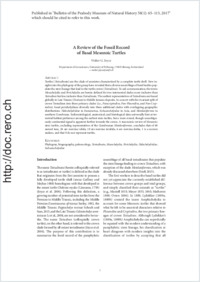A review of the fossil record of basal mesozoic turtles
- Joyce, Walter G. Department of Geosciences, University of Fribourg, Switzerland
-
01.04.2017
Published in:
- Bulletin of the Peabody Museum of Natural History. - 2017, vol. 58, no. 1, p. 65–113
English
Turtles (Testudinata) are the clade of amniotes characterized by a complete turtle shell. New insights into the phylogeny of the group have revealed that a diverse assemblage of fossil turtles populate the stem lineage that lead to the turtle crown (Testudines). To aid communication, the terms Mesochelydia and Perichelydia are herein defined for two internested clades more inclusive than Testudines but less inclusive than Testudinata. The earliest representatives of Testudinata are found globally in Late Triassic (Norian) to Middle Jurassic deposits. In concert with the vicariant split of crown Testudines into three primary clades (i.e., Paracryptodira, Pan- Pleurodira, and Pan-Cryptodira), basal perichelydians diversify into three additional clades with overlapping geographic distributions: Helochelydridae in Euramerica, Sichuanchelyidae in Asia, and Meiolaniformes in southern Gondwana. Sedimentological, anatomical, and histological data universally hint at terrestrial habitat preference among the earliest stem turtles, but a more mixed, though unambiguously continental signal is apparent further towards the crown. A taxonomic review of Mesozoic stem turtles, excluding representatives of the Gondwanan Meiolaniformes, concludes that of 48 named taxa, 26 are nomina valida, 18 are nomina invalida, 4 are nomina dubia, 1 is a nomen nudum, and that 9 do not represent turtles.
- Faculty
- Faculté des sciences et de médecine
- Department
- Département de Géosciences
- Language
-
- English
- Classification
- Palaeontology
- License
-
License undefined
- Identifiers
-
- RERO DOC 288659
- DOI 10.3374/014.058.0105
- Persistent URL
- https://folia.unifr.ch/unifr/documents/305545
Statistics
Document views: 210
File downloads:
- pdf: 916
